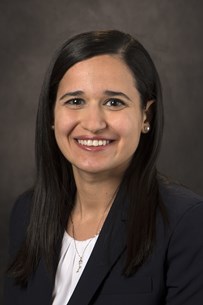Meeting
2019 ASCO Annual Meeting

Division of Cancer Medicine, The University of Texas MD Anderson Cancer Center, Houston, TX
Hind Rafei , Marcelo Fernández-Viña , Yudith Carmazzi , Brandt Moore , Dana Willis , Rafet Basar , Pinaki Prosad Banerjee , May Daher , Chitra Hosing , Partow Kebriaei , Issa F. Khouri , Rohtesh Mehta , Yago Nieto , Muzaffar H. Qazilbash , Elizabeth J. Shpall , Richard E. Champlin , David Marin , Katayoun Rezvani , Kai Cao
Background: NK cells play a pivotal role in cancer immune vigilance. NK cell function is regulated by a balance between activating and inhibitory signals derived from various receptor-ligand interactions. Methods: 390 AML pts received 10/10 unrelated donor SCT. KIR genotype was performed by PCR with sequence specific primers. Hazard ratio (HR) for 2-year relapse was calculated using Fine-Gray regression and adjusted for disease risk index, remission status, pre-SCT MRD, conditioning regimen and presence of HLA-DP mismatch. KIR-ligand (K-L) match was defined as the presence a given KIR in the donor and the presence of its reported ligand in the patient (ex. 2DL1 and HLA-C2). KIRs that have no known ligands were not included in this analysis. The Table shows pt characteristics and K-L matches. Results: There was no correlation between the number of inhibitory or activating KIRs or KIR haplotype (A or B) and the probability of relapse after SCT. However, donor KIRs had a dramatic effect on relapse when they were considered together with the presence of the corresponding ligand in the pt. The 210 pts who had ≥3 inhibitory K-L matches had a significantly higher probability of relapse (HR=1.748, CI=1.147-2.667, p=0.009) than the remaining 180 pts. Similarly, the 96 pts who had at least one known activating K-L match had a lower probability of relapse (HR=0.581, CI=0.345-0.978, p=0.04). When we considered inhibitory and activating K-L matches together, we found that the 168 pts who had ≥3 inhibitory and no activating K-L matches had a significantly higher probability of relapse (HR 2.001, CI=1.376-2.908, p<0.001) than the 222 remaining pts. Conclusions: Donor-pt KIR-ligand matching should be taken into account when choosing unrelated donors for AML pts.
| Characteristic | No. of pts (N= 390) |
|---|---|
| Median age, years (range) | 54.3 (18.1-79.8) |
| Male sex | 184 |
| Conditioning Regimen | |
| Fludarabine-Melphalan | 63 |
| Fludarabine-Busulfan (RIC) | 59 |
| Fludarabine-Busulfan (MAC) | 268 |
| Remission status | |
| CR | 222 |
| No CR | 138 |
| Disease specific risk index | |
| Low | 22 |
| Intermediate | 125 |
| High | 177 |
| Very high | 66 |
| Number of inhibitory K-L matches, Median (range) | 3 (1-5) |
| Number of activating K-L matches, Median (range) | 0 (0-4) |
| K-L matches | |
| 2DL1-HLA C2 | 226 |
| 2DL2-HLA C1, B46:01, B73:01 | 150 |
| 2DL3-HLA C1, B46:01, B73:01 | 300 |
| 3DL1-HLA Bw4 | 212 |
| 3DL2-HLA A3, A11 | 147 |
| 2DS1-HLA C02:02, C04:01, C 05:01, C06:02, C17:0, C18:02 | 39 |
| 2DS2-HLA A11:01 | 21 |
| 2DS4-HLA C01:02, C02:02, C05:01, C14:02, C16:01, A11:01, A11:02 | 44 |
| 3DS1-HLA B27:05, Bw4T80 | 60 |
Disclaimer
This material on this page is ©2024 American Society of Clinical Oncology, all rights reserved. Licensing available upon request. For more information, please contact licensing@asco.org
2019 ASCO Annual Meeting
Poster Session
Hematologic Malignancies—Leukemia, Myelodysplastic Syndromes, and Allotransplant
Hematologic Malignancies—Leukemia, Myelodysplastic Syndromes, and Allotransplant
Allogenic Stem Cell Transplantation
J Clin Oncol 37, 2019 (suppl; abstr 7049)
10.1200/JCO.2019.37.15_suppl.7049
7049
424
Abstract Disclosures
2023 ASCO Annual Meeting
First Author: Vincent Nicchi
2023 ASCO Annual Meeting
First Author: Anshu Hemrajani
2022 ASCO Annual Meeting
First Author: Wei Jiang
2023 ASCO Annual Meeting
First Author: Alexandra Ewa Rojek